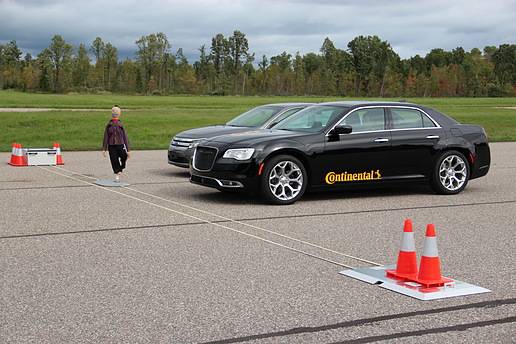 别撞到过马路的假人了!大陆集团的全新超宽频带传感器系统正在公司位于密歇根州的研发中心进行演示。
别撞到过马路的假人了!大陆集团的全新超宽频带传感器系统正在公司位于密歇根州的研发中心进行演示。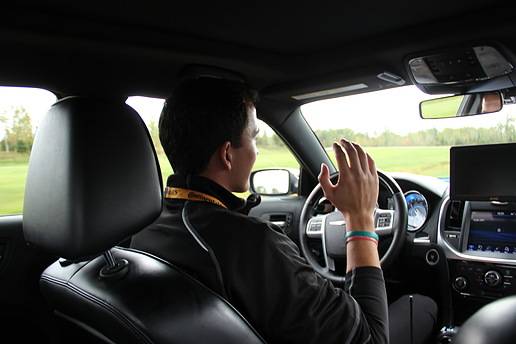 大陆集团工程师Steffen Hartmann坐在大陆“巡航司机”演示车中,双手并没有握着方向盘,即使此时车辆正在进行高速行驶。
大陆集团工程师Steffen Hartmann坐在大陆“巡航司机”演示车中,双手并没有握着方向盘,即使此时车辆正在进行高速行驶。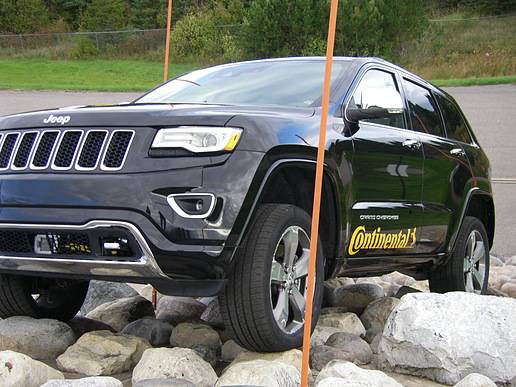 一辆配备大陆系统的吉普大切诺基正在爬30º的岩石坡。
一辆配备大陆系统的吉普大切诺基正在爬30º的岩石坡。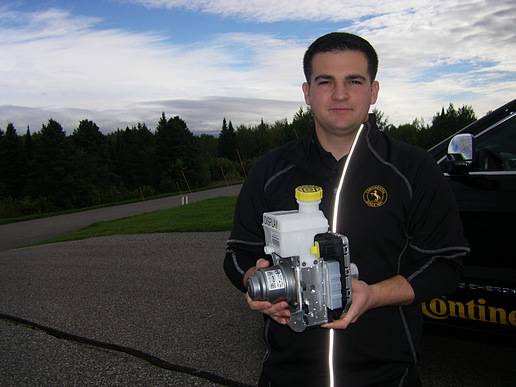 大陆集团的Tim Buchert手握MKC1制动系统。
大陆集团的Tim Buchert手握MKC1制动系统。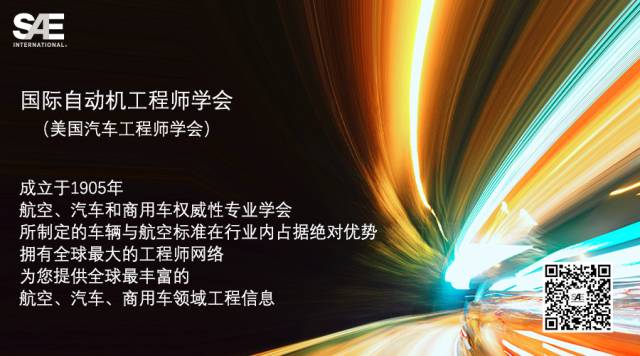
无论是可以指挥车辆在越野环境“上山下坡”的制动巡航控制系统,还是可以监测驾驶员视野以外危险道路用户的传感系统,这些都是大陆集团(Continental)的最新科技研发成果,目前基本均已做好量产准备,或已有量产计划。
如果驾驶员视线受阻,行人、慢跑者和自行车等道路弱势用户都很容易暴露在车辆带来的危险之中。车辆配备的摄像头可以提醒驾驶员注意一些被其他车辆或障碍物遮挡的道路使用者,有时甚至可以更早发现潜在的风险。
大陆集团正在测试利用超宽频带传感器,识别危险道路使用者。近日,《汽车工程》在大陆集团位于密歇根州的研发中心对这种传感器进行了测试。具体来说,传感器安装在演示车的两侧后视镜和副驾驶侧的C柱上,但只有在特定距离内才能发挥作用,这与电子车钥匙采用的传感技术类似。另外,测试中还安排了一个装备传感器的安全测试假人,站在马路中间充当行人。
通过综合参考传感器信号,演示车辆的通信网络可以更快监测到安全测试假人“目标”,速度比传统摄像头监测系统快三到四秒。
大陆集团系统、技术及底盘与安全部北美总监Jeremy McClain表示,“这个演示让我们开始思考,到底该如何避免事故发生,保护道路弱势用户,并拿出一个适合未来交通环境的解决方案。”
“巡航司机”系统(Cruising Chauffeur)
正如V2V和V2I通信一样,了解道路用户的确切位置有助于防止意外的发生。大陆软件工程师Ganesh Adireddy说:“现在的重点就是如何获取道路行人的信息,未来我们在实际应用中可能会利用行人的智能手机、智能手表或特殊应答器等装置。”与GPS系统相比,短程通信技术的定位功能更加准确,也更加快速。
在自动驾驶场景中,能否获知精确的位置信息至关重要。正因如此,大陆集团专门研发了“巡航司机(Cruising Chauffeur)”功能,从而提升车辆的传感能力,辅助远程和近程雷达摄像头系统的工作。公司V2X团队高级技术专家Eric Mertz表示,大陆的M2XPro算法可以综合考虑GPS和车辆传感器系统的数据输入。
“在一些情况下,比如市内建筑物太多的时候,GPS信号就可能会反射在这些建筑物上。”Mertz指出,“这种情况可能会导致GPS系统给出错误的位置信息。”然而,通过综合M2XPro和 “巡航司机”通信技术,大陆集团得以将定位误差控制在1.5米以内。
大陆自动驾驶项目测试/验证工程师SteffenHartmann表示,最近,公司还给“巡航司机”演示车增加了自动变道和车道跟随功能。当采用“巡航司机”系统的车辆进入自动驾驶模式时,如果驾驶员发出变道指示,车辆就会在安全时自动进行变道。另外,如果前方车辆减速,“巡航司机”系统就会通过人机界面提示驾驶员可以变道。
目前,大陆集团位于美国、墨西哥、德国、日本和中国的研发团队均在进行“巡航司机”的研发。Hartmann表示,“我们将不断取得越来越多进步,直至最终实现SAE 4级自动驾驶的水平。”大陆官员预测,高级别自动驾驶技术将在2020年成型,而全自动驾驶技术则将在2025年成型。
“安静”的越野功能
大陆集团的MK C1电子制动系统支持越野巡航控制(OCC)功能,目前已经做好量产准备。最近,MK C1系统刚刚登陆欧洲版阿尔法罗密欧Giulia轿车。
这款创新MK C1系统集成了制动促动、制动升压和控制模块,重约13磅(6公斤),比传统制动系统轻大约4.4到6.6磅(2到3公斤)。大陆电子制动系统部汽车测试工程师Tim Buchert表示,电动-液压式MKC1制动系统采用了线性促动器,而非传统制动系统的双活塞或六活塞泵。
在演示中,一辆配备了MK C1电子制动系统的吉普大切诺基(Jeep Grand Cherokee)将OCC模块设定为1.2 mph(1.9 km/h)。此时,驾驶员仅用控制方向盘即可,车辆不仅可以爬上30º的岩石坡,在挂倒挡时也能下到类似的坡度。
“系统在提升制动压力时非常安静,因此车辆在上山下坡时并不存在任何NVH或抖动问题。”Buchert解释道,“在混合动力汽车中,你可以踩刹车向电机发送减速命令,汽车将首先通过电机减速,而后慢慢进入常规制动过程。”
A braking and cruise-control system that can move a vehicle up and down steep off-road hills. Vehicles that can detect at-risk road users not in the driver’s field of vision. These production-ready and production-intent technologies are in Continental’s product pipeline.
Pedestrians, joggers and bicyclists are vulnerable to a vehicle impact when hidden from a driver’s sight. While a camera-equipped vehicle can alert its driver to someone partially concealed by a parked car or other obstruction, even earlier detection is possible.
Continental is testing the use of ultra-wide-band sensors to identify at-risk road users. These proximity-based sensors, like those used in key fobs, are located on the side mirrors and on the passenger-side C-pillar of a demonstrator car tested by Automotive Engineering recently at the supplier's Brimley, MI, Development Center. A sensor-equipped safety dummy stands in for a wandering pedestrian.
By triangulating the sensor signals, the sedan’s communication network detects the safety dummy "target" three to four seconds earlier than a vehicle using cameras.
“This demonstration is a thought-starter. We have to start thinking about how to avoid accidents with vulnerable road users in order to have a solution in the future,” said Jeremy McClain, Continental’s North American Director of Systems and Technology, Chassis & Safety Division.
The 'Cruising Chauffeur'
Like V2V and V2I communications, knowing the precise location of a road user can help prevent an accident. Said software engineer Ganesh Adireddy, “It’s all about sharing information from the pedestrian road user, who in actual use likely would have a smart phone, a smart watch, or a special transponder.” Short-range communication can identify a person’s position more accurately and do so more quickly than GPS.
Precise location information is critically relevant in autonomous driving scenarios, which is why Continental’s "Cruising Chauffeur" feature is designed to add another layer of sensing capability to compliment long- and short-range radars and cameras. According to Eric Mertz, senior staff technical specialist for the V2X team, Continental’s M2XPro algorithm fuses GPS and vehicle sensor data.
“There are situations, like an urban canyon, where a GPS signal reflects off buildings," Mertz noted. "And when that happens, it gives a false indication of where you’re at in the city.” By incorporating M2XPro with the Cruising Chauffeur’s existing communication technology, positioning accuracy below 1.5 m (5 ft) is expected, he said.
Automated lane change and lane-change recommendation capabilities were added recently to the Cruising Chauffeur demo vehicles, according to Steffen Hartmann, test and validation engineer involved with the automated driving project. When a Cruising Chauffeur vehicle is in automated driving mode, a driver’s turn signal movement tells the car to make a lane change if it’s safe to do so. A lane change recommendation occurs via the HMI interface if a vehicle in front of the Cruising Chauffeur slows down.
Engineering teams in the U.S., Mexico, Germany, Japan, and Shanghai are working on the Cruising Chauffeur. “We’re making more and more steps toward our final SAE Level 4 automated driving vehicle,” said Hartmann. Continental officials expect technology for highly automated driving to be ready by 2020 and fully automated driving technology to be ready by 2025.
Tip-toeing off road
Continental is production-ready with its MK C1 electronic brake system with Off-Road Cruise Control (OCC). The MK C1 portion of the system recently debuted on the European-market Alfa Romeo Giulia.
The innovative MK C1 unit integrates brake actuation, brake booster, and control systems. It weighs 13 lb (6 kg), about 4.4-6.6 lb (2-3 kg) less than a traditional system. According to Tim Buchert, a vehicle test engineer with the electronic braking systems group, the electro-hydraulic MK C1 uses a linear actuator instead of the two- or six-piston pump that’s in conventional braking systems.
During a demonstration, a Jeep Grand Cherokee equipped with the MK C1 only required the driver to steer the SUV after the OCC was set at 1.2 mph (1.9 km/h). The vehicle climbed a rocky 30º grade. It also moved itself down, and up, a similarly steep grade while in reverse gear.
“The system is silent when building up brake pressure, so there isn’t any NVH or pulsating as the vehicle climbs or descends the hill," Buchert explained. "In a hybrid driving application, you can hit the brake pedal to send a deceleration request to the electric motors. The vehicle will slow down using the electric motors and over time slowly fade-in conventional braking.”
Author: Kami Buchholz
Source: SAE Automotive Engineering Magazine
等级
打分
- 2分
- 4分
- 6分
- 8分
- 10分
平均分
- 作者:Kami Buchholz
- 行业:汽车
- 主题:零部件安全性人体工程学/人因工程学电气电子与航空电子
